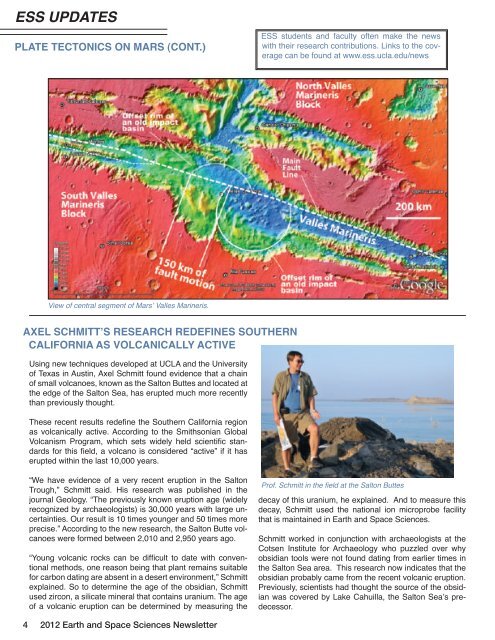2012 Alumni Newsletter (PDF) - Department of Earth and Space ...
2012 Alumni Newsletter (PDF) - Department of Earth and Space ...
2012 Alumni Newsletter (PDF) - Department of Earth and Space ...
You also want an ePaper? Increase the reach of your titles
YUMPU automatically turns print PDFs into web optimized ePapers that Google loves.
ESS UPDATES<br />
PLATE TECTONICS ON MARS (CONT.)<br />
View <strong>of</strong> central segment <strong>of</strong> Mars’ Valles Marineris.<br />
AXEL SCHMITT’S RESEARCH REDEFINES SOUTHERN<br />
CALIFORNIA AS VOLCANICALLY ACTIVE<br />
Using new techniques developed at UCLA <strong>and</strong> the University<br />
<strong>of</strong> Texas in Austin, Axel Schmitt found evidence that a chain<br />
<strong>of</strong> small volcanoes, known as the Salton Buttes <strong>and</strong> located at<br />
the edge <strong>of</strong> the Salton Sea, has erupted much more recently<br />
than previously thought.<br />
These recent results redefine the Southern California region<br />
as volcanically active. According to the Smithsonian Global<br />
Volcanism Program, which sets widely held scientific st<strong>and</strong>ards<br />
for this field, a volcano is considered “active” if it has<br />
erupted within the last 10,000 years.<br />
“We have evidence <strong>of</strong> a very recent eruption in the Salton<br />
Trough,” Schmitt said. His research was published in the<br />
journal Geology. “The previously known eruption age (widely<br />
recognized by archaeologists) is 30,000 years with large uncertainties.<br />
Our result is 10 times younger <strong>and</strong> 50 times more<br />
precise.” According to the new research, the Salton Butte volcanoes<br />
were formed between 2,010 <strong>and</strong> 2,950 years ago.<br />
“Young volcanic rocks can be difficult to date with conventional<br />
methods, one reason being that plant remains suitable<br />
for carbon dating are absent in a desert environment,” Schmitt<br />
explained. So to determine the age <strong>of</strong> the obsidian, Schmitt<br />
used zircon, a silicate mineral that contains uranium. The age<br />
<strong>of</strong> a volcanic eruption can be determined by measuring the<br />
4 <strong>2012</strong> <strong>Earth</strong> <strong>and</strong> <strong>Space</strong> Sciences <strong>Newsletter</strong><br />
ESS students <strong>and</strong> faculty <strong>of</strong>ten make the news<br />
with their research contributions. Links to the coverage<br />
can be found at www.ess.ucla.edu/news<br />
Pr<strong>of</strong>. Schmitt in the field at the Salton Buttes<br />
decay <strong>of</strong> this uranium, he explained. And to measure this<br />
decay, Schmitt used the national ion microprobe facility<br />
that is maintained in <strong>Earth</strong> <strong>and</strong> <strong>Space</strong> Sciences.<br />
Schmitt worked in conjunction with archaeologists at the<br />
Cotsen Institute for Archaeology who puzzled over why<br />
obsidian tools were not found dating from earlier times in<br />
the Salton Sea area. This research now indicates that the<br />
obsidian probably came from the recent volcanic eruption.<br />
Previously, scientists had thought the source <strong>of</strong> the obsidian<br />
was covered by Lake Cahuilla, the Salton Sea’s predecessor.


